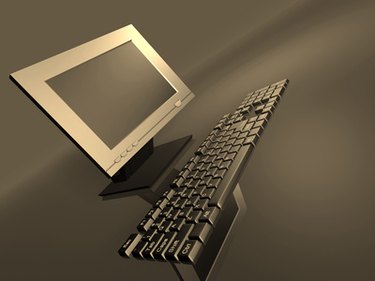
Microsoft's Windows operating systems use the Winsock protocol to link with and communicate with other computers on the Internet. Programs may cause the Winsock protocol to become corrupted, which then causes Windows to display socket error messages. Corrupted Winsock protocol files may also prevent you from connecting with Internet resources such as websites, email or multi-player games without presenting you a socket error message. Some Internet-based programs must be reinstalled or repaired after resetting the Winsock protocol.
Windows XP
Video of the Day
Step 1
Click on "Start," then "Run." Type "regedit" (without quotes), then press the "Enter" key.
Video of the Day
Step 2
Navigate to the "HKEY_LOCAL_MACHINE\SYSTEM\CurrentControlSet\Services\Winsock" registry entry in the left column by clicking on the "+" symbols next to categories to expand them. Highlight the "Winsock" entry by clicking on it once.
Step 3
Click on "File," then "Export."
Step 4
Save the file to external media such as a USB thumb drive, external hard drive, SD card or CD/DVD.
Step 5
Right-click "Winsock," and left click on "Delete." Click on "Yes" to confirm the deletion.
Step 6
Locate the "HKEY_LOCAL_MACHINE\SYSTEM\CurrentControlSet\Services\Winsock2" registry entry in the left column. Highlight the "Winsock" entry by clicking on it once.
Step 7
Click on "File," then "Export."
Step 8
Save the file to the same external media you used earlier.
Step 9
Right-click "Winsock2" in the Registry Editor, then left-click on "Delete." Click on "Yes" to confirm the deletion.
Step 10
Close the Registry Editor.
Step 11
Click on "Start," then "Control Panel." Double-click "Network Connections."
Step 12
Right-click "Local Area Connections," then left-click "Properties."
Step 13
Click on "Install" in the Local Area Connection Properties box. Select "Protocol," then click on "Add."
Step 14
Click on "Have Disk."
Step 15
Type "C:\windows\inf" (without quotes) in the "Copy manufacturer's files from" field. Click on "OK."
Step 16
Select "Internet Protocol (TCP/IP)," then click on "OK." Restart the computer
Windows Vista and Windows 7
Step 1
Click on "Start," then type "cmd" (without quotes) in the "Start Search" text field.
Step 2
Right-click on "cmd.exe," and left-click on "Run as administrator." Press "Continue."
Step 3
Type "netsh winsock reset" (without quotes), and press "Enter."
Step 4
Type "exit" (without quotes), then press the "Enter" key.
Step 5
Click on "Start," then "Control Panel." Click on "Classic View" in the left column if applicable.
Step 6
Double-click "Network and Sharing Center" in Windows Vista and "Find and Fix Problems" in the "System and Security" header in Windows 7.
Step 7
Click on the "Diagnose and repair" link in the left column in the Network and Sharing Center. Click on "View all" in the Task pane if using Windows 7, then click on "Internet Explorer Performance." Click "Next," then allow Windows 7 to automatically fix the problem. Click "Close" to finish.
- Microsoft: You Receive an \"An Operation Was Attempted on Something That Is Not A Socket\" Error Message
- Microsoft: How to Determine and to Recover from Winsock2 Corruption
- Microsoft: How to Troubleshoot Network Connectivity Problems in Internet Explorer
- Microsoft: Winsock Reference
- Microsoft: Winsock 2 Reference